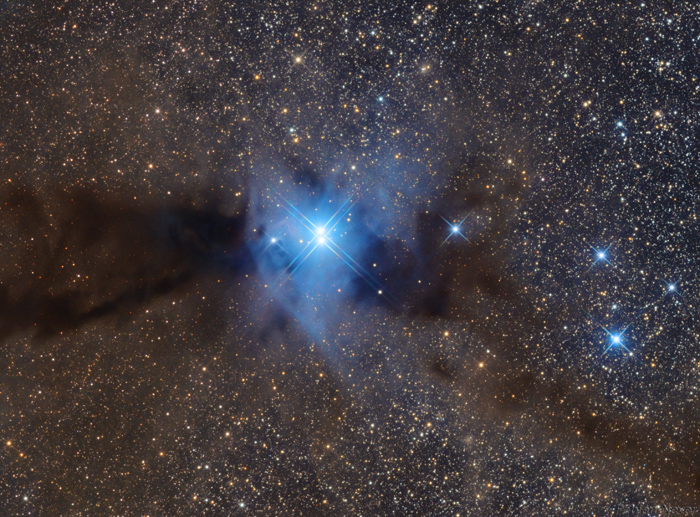


| Optics | ASA 12" Newton at f3.6 |
| Mount | ASA DDM85 |
| Camera | FLI ML 8300 |
| Filters | LRGB |
| Date | July 2013 |
| Location | Tivoli Astrofarm, Namibia |
| SQM-L | - (mag 7 sky) |
| Exposure | LRGB = 60-80-85-75min total: 5h |
| FWHM | 3.1 arcseconds |
| Programs used | CCDAutoPilot, MaxIm DL, PixInsight, Photoshop CS6 |
| Notes | My first image with a Newton Astrograph |
Bernes 149 is an obscure nebula complex consisting of the reflection nebula GN 16.05.2 at the centre of an
elongated dusty dark nebula. Although mostly unknown to amateurs, it has been well studied by professionals and is
also known as the Lupus 3 cloud. The name comes from its connection with many other dark clouds in the constellation
of Lupus. Dominating the centre of the image are the blazing bright stars HR 5999 and HR 6000. They belong to a
class of YSO known as Herbig Ae/Be stars, which are intermediate mass pre-main sequence precursors to supergiant
stars. The central reflection nebula is illuminated by HR 5999, the southern of the pair. Out of all the Lupus clouds,
Lupus 3 exhibits the highest rate of star formation. Searches for young stellar objects have yielded the detection
of more than a hundred x-ray sources in a 30 arcminute radius around HR 5999 and HR 6000. The Lupus 3 cloud also
contains protostars with detected jets and outflows and Herbig Haro objects have been found near the central region
(not visible in image). In the large image, the Herbig Haro object HH 78 can be discerned in the left half of the
dark cloud. The Lupus clouds are approximately 450-650 light years away. [Text: Sakib Rasool]